Restful Web Services Using Apache Cxf and Spring Example
![]()
SOAP Microservices with Spring Boot, Part 1 using Apache CXF
This is the first part of a series of articles where we build a SOAP microservice with Spring Boot using several libraries for the SOAP implementation. This article explains the implementation with Apache CXF Library. I created a WSDL with an imported XSD file that represents the service from a legacy system that we want to update to a microservice architecture. I will show you the steps to generate the code and implement the service.
If you want to skip the introduction and go directly to the code, then you can find it in my GitHub repository ws-employee-soapcxf
SOAP Microservices with Spring Boot and Apache CXF
A docker container created with Spring Boot exposing a SOAP endpoint for a legacy client
The tech stack for this POC is:
- Spring Boot 2.3.4
- Java 15
- Apache CXF 3.4
- REST Assured 4.3
- Docker
Software requirements
Workstation must be properly configured with next tools:
- Java 15 JDK - https://jdk.java.net/15/
- Maven - https://maven.apache.org/download.cgi
Optional tools
- Docker - https://www.docker.com/products/docker-desktop
- Docker hub account with token access enabled
WSDL and Domain Model
In our example, we are going to work in a fictitious Employee SOAP service with 2 operations:
- GetEmployeeById
- GetEmployeeByName
For the demo, I separated the XSD from the WSDL. In a real scenario, this will be the most followed pattern but expect to have more than one XSD in different folders. The employee.xsd has the full domain model for the service, next diagram shows the main response sent back to the client
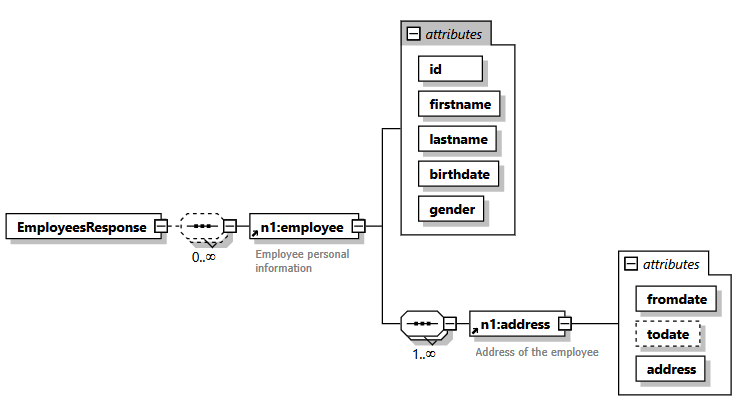
The WSDL…
Introduction
Just wait... SOAP Microservices? Nowadays, we have different microservice architectures based on technologies like REST webservices or RPC protocols such as gRPC. So why should we be interested in implementing a microservice using an old protocol like SOAP? Well, this can be particularly useful when you are on the migration path from an old legacy monolithic application where you have other systems that are connected to it through SOAP services. There are many scenarios where these systems (clients) can not be updated, therefore can not be connected to a new infrastructure, for example:
- The company doesn't have the source code of these clients, believe me, this happens very often or doesn't know the source version deployed on production.
- There are no human resources or technical support to apply the changes and test the legacy clients.
- The cost of updating them is extremely high because of the reason mentioned previously or because of the need for paying license fees
- Updating these clients doesn't bring any business value to the organization, so there is no need to change something that is working correctly just because you are introducing a new architecture.
Among these and other reasons, we need to provide the same interface for these old clients.
Get the WSDL for the service
Getting the WSDL from an existing SOAP web service is very simple; the standardized way to do it (although it may depend on the framework used to create the webservice) is by postfixing the URL with ?WSDL or .WSDL example:
http://mywebservice.domain:8080/endpoint?WSDL This approach is commonly known as contract-first; we start with the WSDL contract, and then we use Java to implement it. Many times the WSDL comes with the domain model in separate XSD's files.
In our example, we are going to work in a fictitious Employee SOAP service with 2 operations:
- GetEmployeeById
- GetEmployeeByName
For the demo, I separated the XSD from the WSDL. This will be the most followed pattern but expect to have more than one XSD in different folders. The employee.xsd has the full domain model for the service. The next diagram shows the main response sent back to the client.

The WSDL is used for describing the functionality of the SOAP-based webservice. The most important section for this article is the wsdl:portType. This section defines the interface for the service we want to implement: operations, input, and output parameters:
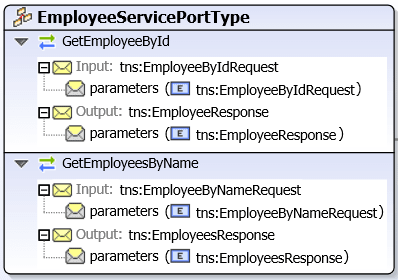
Next is the WSDL section for wsdl:portType:
<!--This element defines the service operations and the combination of input and output elements to clients--> <wsdl:portType name= "EmployeeServicePortType" > <wsdl:operation name= "GetEmployeeById" > <wsdl:input message= "tns:EmployeeByIdRequest" /> <wsdl:output message= "tns:EmployeeResponse" /> </wsdl:operation> <wsdl:operation name= "GetEmployeesByName" > <wsdl:input message= "tns:EmployeeByNameRequest" /> <wsdl:output message= "tns:EmployeesResponse" /> </wsdl:operation> </wsdl:portType> The complete WSDL file is here: EmployeeServices.wsdl
Setting up the project
The project uses maven, and the properties and dependencies of the pom.xml are these:
<properties> <!-- Override BOM property in Spring Boot for Rest Assured and Groovy--> <!-- With rest-assured 4.3.X upgrade the Groovy from 2.5.7 to 3.0.2 --> <rest-assured.version>4.3.1</rest-assured.version> <groovy.version>3.0.2</groovy.version> <!-- Other properties--> <java.version>15</java.version> <cxf.version>3.4.0</cxf.version> <springboot.version>2.3.3.RELEASE</springboot.version> </properties> <dependencies> <dependency> <groupId>org.springframework.boot</groupId> <artifactId>spring-boot-starter-web</artifactId> </dependency> <dependency> <groupId>org.projectlombok</groupId> <artifactId>lombok</artifactId> <optional>true</optional> </dependency> <dependency> <groupId>org.springframework.boot</groupId> <artifactId>spring-boot-starter-test</artifactId> <scope>test</scope> <exclusions> <exclusion> <groupId>org.junit.vintage</groupId> <artifactId>junit-vintage-engine</artifactId> </exclusion> </exclusions> </dependency> <!-- CXF Framework --> <dependency> <groupId>org.apache.cxf</groupId> <artifactId>cxf-spring-boot-starter-jaxws</artifactId> <version>${cxf.version}</version> </dependency> <!-- Required if you need to log the request/response --> <dependency> <groupId>org.apache.cxf</groupId> <artifactId>cxf-rt-features-logging</artifactId> <version>${cxf.version}</version> </dependency> <!-- Testing --> <dependency> <groupId>io.rest-assured</groupId> <artifactId>rest-assured</artifactId> <scope>test</scope> </dependency> </dependencies> Notes:
- Rest Assured. We are using the latest version at the moment of writing the article. The version 4.3.1 requires groovy 3.0.2; we archive the correct configuration by overriding the parent pom libraries by using the pom properties
- Apache CXF. Dependency cxf-rt-features-logging is only required if we need to log the request/response. This demo prints the request/response payload on the application console.
Generating the code
We will generate the java classes that map to the domain model and the operations described in the WSDL. We are going to use the maven plugin from the Apache CXF project to generate the code.
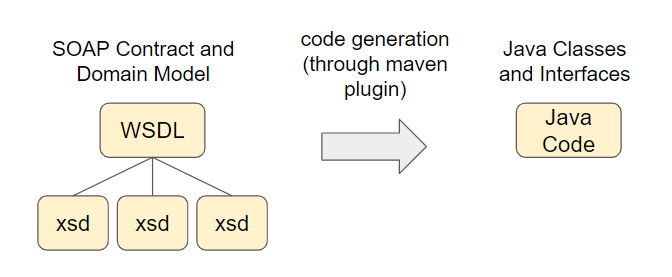
The XSD and wsdl files are located under the next structure:
<source-code> ├───src └───main └───resources └───wsdl Next is the configuration of the plugin in the pom.xml
<plugin> <groupId>org.apache.cxf</groupId> <artifactId>cxf-codegen-plugin</artifactId> <version>${cxf.version}</version> <executions> <execution> <id>generate-sources</id> <phase>generate-sources</phase> <configuration> <sourceRoot>${project.build.directory}/generated-sources/cxf</sourceRoot> <wsdlOptions> <wsdlOption> <wsdl>${basedir}/src/main/resources/wsdl/EmployeeServices.wsdl</wsdl> </wsdlOption> </wsdlOptions> </configuration> <goals> <goal>wsdl2java</goal> </goals> </execution> </executions> </plugin> The plugin will generate the java classes in the next directory:
<source-code>/target/generated-sources/cxf Generate the java classes by running in the command window in the project root:
The next image shows the generated classes and highlights the one we will use as the endpoint to implement the webservice: EmployeeServicePortType.
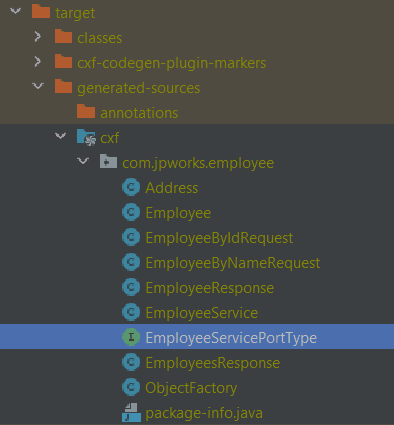
- Domain classes. These are the XSD file elements and represent the input and output parameters of the web service. The classes are: Address, Employee, EmployeeResponse, EmployeeByIdRequest, EmployeeByNameRequest.
- WSDL classes. These classes describe the service operations and its input and output elements: EmployeeService, EmployeeServicePortType.
Configure Apache CXF Runtime
The configuration is straightforward. In the application.yml we can override the base path for Apache CXF, by default, it is /services in our example, we will use /soap.
We need to provide the path for the service exposed: /service/employee. We provide this configuration by creating a @Bean Endpoint:
import org.springframework.context.annotation.Configuration ; import javax.xml.ws.Endpoint ; @Configuration public class ApplicationConfiguration { @Autowired private Bus bus ; @Bean public Endpoint endpoint ( EmployeeEndpoint employeeEndpoint ) { EndpointImpl endpoint = new EndpointImpl ( bus , employeeEndpoint ); endpoint . publish ( "/service/employee" ); return endpoint ; } } Implementing the service
One of the generated classes is EmployeeServicePortType as described wsdl:portType section. This is an interface with the 2 operations and input/output parameters. In the next example, we create the class EmployeeEndpoint that implements EmployeeServicePortType. For demo purposes, we are using a fake backend that will provide the data for the service. The backend can be, for example, a datastore or another webservice.
import lombok.extern.slf4j.Slf4j ; import org.apache.cxf.feature.Features ; import org.springframework.stereotype.Service ; import com.jpworks.employee.* ; @Service @Slf4j @Features ( features = "org.apache.cxf.ext.logging.LoggingFeature" ) public class EmployeeEndpoint implements EmployeeServicePortType { BackendService backendService ; public EmployeeEndpoint ( BackendService backendService ){ this . backendService = backendService ; } @Override public EmployeesResponse getEmployeesByName ( EmployeeByNameRequest parameters ) { EmployeesResponse employeesResponse = new EmployeesResponse (); try { employeesResponse . getEmployee (). addAll ( backendService . getEmployeesByName ( parameters . getFirstname (), parameters . getLastname ())); } catch ( Exception e ){ log . error ( "Error while setting values for employee object" , e ); } return employeesResponse ; } @Override public EmployeeResponse getEmployeeById ( EmployeeByIdRequest parameters ) { EmployeeResponse employeeResponse = new EmployeeResponse (); try { employeeResponse . setEmployee ( backendService . getEmployeeById ( parameters . getId ())); } catch ( Exception e ){ log . error ( "Error while setting values for employee object" , e ); } return employeeResponse ; } } In the example above, we use @Features to log the request and response in the application log.
Running the application
In a command window on the root project run:
The log in the console:
. ____ _ __ _ _ /\\ / ___'_ __ _ _(_)_ __ __ _ \ \ \ \ ( ( )\___ | '_ | '_| | '_ \/ _` | \ \ \ \ \\/ ___)| |_)| | | | | || (_| | ) ) ) ) ' |____| .__|_| |_|_| |_\__, | / / / / =========|_|==============|___/=/_/_/_/ :: Spring Boot :: (v2.3.4.RELEASE) 2020-10-02 22:23:49.563 INFO 1 --- [ main] com.jpworks.datajdbc.MainApplication : Starting MainApplication v1.0.1-SNAPSHOT on b6e50b2f461b with PID 1 (/app.jar started by root in /) 2020-10-02 22:23:49.572 DEBUG 1 --- [ main] com.jpworks.datajdbc.MainApplication : Running with Spring Boot v2.3.4.RELEASE, Spring v5.2.9.RELEASE 2020-10-02 22:23:49.573 INFO 1 --- [ main] com.jpworks.datajdbc.MainApplication : The following profiles are active: local 2020-10-02 22:23:51.163 INFO 1 --- [ main] o.s.b.w.embedded.tomcat.TomcatWebServer : Tomcat initialized with port(s): 8081 (http) 2020-10-02 22:23:51.179 INFO 1 --- [ main] o.apache.catalina.core.StandardService : Starting service [Tomcat] 2020-10-02 22:23:51.179 INFO 1 --- [ main] org.apache.catalina.core.StandardEngine : Starting Servlet engine: [Apache Tomcat/9.0.38] 2020-10-02 22:23:51.254 INFO 1 --- [ main] o.a.c.c.C.[Tomcat].[localhost].[/] : Initializing Spring embedded WebApplicationContext 2020-10-02 22:23:51.255 INFO 1 --- [ main] w.s.c.ServletWebServerApplicationContext : Root WebApplicationContext: initialization completed in 1625 ms 2020-10-02 22:23:51.541 INFO 1 --- [ main] o.s.boot.web.servlet.RegistrationBean : Servlet CXFServlet was not registered (possibly already registered?) 2020-10-02 22:23:51.885 INFO 1 --- [ main] o.a.c.w.s.f.ReflectionServiceFactoryBean : Creating Service {http://service.datajdbc.jpworks.com/}EmployeeEndpointService from class com.jpworks.employee.EmployeeService 2020-10-02 22:23:52.455 INFO 1 --- [ main] org.apache.cxf.endpoint.ServerImpl : Setting the server's publish address to be /service/employee 2020-10-02 22:23:52.646 INFO 1 --- [ main] o.s.s.concurrent.ThreadPoolTaskExecutor : Initializing ExecutorService 'applicationTaskExecutor' 2020-10-02 22:23:52.870 INFO 1 --- [ main] o.s.b.w.embedded.tomcat.TomcatWebServer : Tomcat started on port(s): 8081 (http) with context path '' 2020-10-02 22:23:52.889 INFO 1 --- [ main] com.jpworks.datajdbc.MainApplication : Started MainApplication in 4.018 seconds (JVM running for 4.625) To get the available endpoints, write in the browser:
http://localhost:8081/soap 
To get the wsdl of the service, write in the browser:
http://localhost:8081/soap/service/employee?wsdl 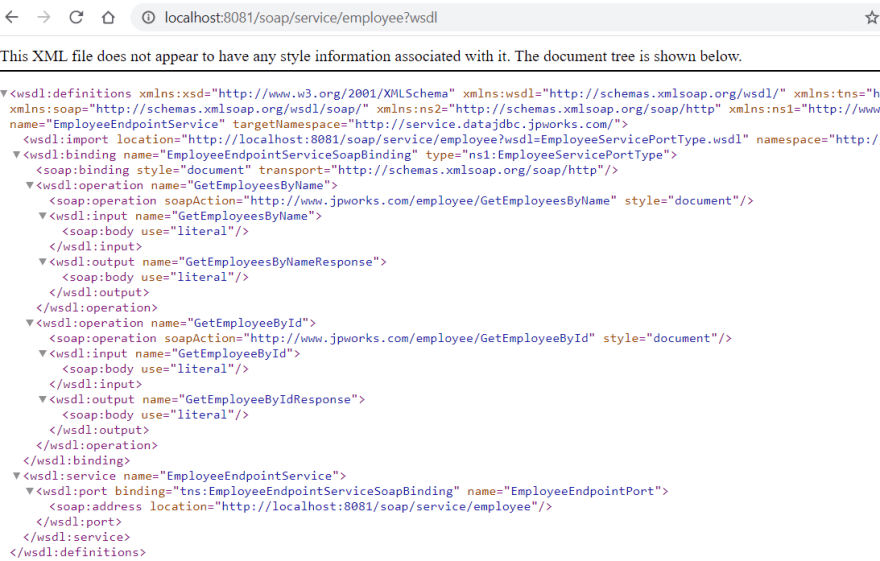
We can test the application using an Http Client like PostMan or Jmeter using a POST call (for test cases, the application uses RestAssured library). But I will use the traditional SoapUI, the endpoint for the service is: http://localhost:8081/soap/service/employee.

On the application console you will see the request/response logged:
2020-10-06 15:36:01.396 INFO 102696 --- [ main] com.jpworks.datajdbc.MainApplication : Started MainApplication in 3.104 seconds (JVM running for 3.988) 2020-10-06 15:36:23.958 INFO 102696 --- [nio-8081-exec-1] o.a.c.s.EmployeeServicePortType.REQ_IN : REQ_IN Address: http://localhost:8081/soap/service/employee HttpMethod: POST Content-Type: text/xml;charset=UTF-8 ExchangeId: 872e1281-4545-45ad-9871-331d96c450cf ServiceName: EmployeeEndpointService PortName: EmployeeEndpointPort PortTypeName: EmployeeServicePortType Headers: {SOAPAction="http://www.jpworks.com/employee/GetEmployeesByName", host=localhost:8081, connection=Keep-Alive, content-type=text/xml;charset=UTF-8, Content-Length=273, accept-encoding=gzip,deflate, user-agent=Apache-HttpClient/4.5.5 (Java/12.0.1)} Payload: <soapenv:Envelope xmlns:soapenv="http://schemas.xmlsoap.org/soap/envelope/" xmlns:emp="http://www.jpworks.com/employee"> <soapenv:Header/> <soapenv:Body> <emp:EmployeeByNameRequest firstname="John" lastname="Miller"/> </soapenv:Body> </soapenv:Envelope> 2020-10-06 15:36:23.995 INFO 102696 --- [nio-8081-exec-1] o.a.c.s.E.RESP_OUT : RESP_OUT Address: http://localhost:8081/soap/service/employee Content-Type: text/xml ResponseCode: 200 ExchangeId: 872e1281-4545-45ad-9871-331d96c450cf ServiceName: EmployeeEndpointService PortName: EmployeeEndpointPort PortTypeName: EmployeeServicePortType Headers: {} Payload: <soap:Envelope xmlns:soap="http://schemas.xmlsoap.org/soap/envelope/"><soap:Body><EmployeesResponse xmlns="http://www.jpworks.com/employee"><employee id="1" firstname="Jeffery" lastname="Lewis" birthdate="2000-01-01" gender="M"/><employee id="2" firstname="Francis" lastname="Stevens" birthdate="1999-01-01" gender="M"/></EmployeesResponse></soap:Body></soap:Envelope> Conclusion
This article explained why it is still important to consider SOAP as a tool in the migration path from any legacy application. We have used a demo WSDL and reviewed the relevant sections. We have learned how to use Apache CXF for SOAP implementation and configuration.
If you have any questions, feel free to ask in the comments; thanks for reading!
Restful Web Services Using Apache Cxf and Spring Example
Source: https://dev.to/jpontdia/soap-microservices-with-spring-boot-and-cxf-on-the-monolithic-migration-path-439h
0 Response to "Restful Web Services Using Apache Cxf and Spring Example"
Post a Comment